Ponatinib Induces a Procoagulant Phenotype in Human Coronary Endothelial Cells via Inducing Apoptosis
Abstract
1. Introduction
2. Materials and Methods
2.1. Endothelial Cell Culturing and Treatment
2.2. Phosphatidylserine (PS) Exposure and Microvesicle Count Assay Using a Flow Cytometer
2.3. Measurement of Thrombin Generating Potential of Endothelial Cells and Microvesicles
2.4. Western Blot Analysis of Bax and Bcl-xL Proteins
2.5. Investigation of F3, THBD, and VCAM1 mRNA Expression
2.6. Statistical Analysis
3. Results
3.1. Ponatinib Enhances Phosphatidylserine (PS) Exposure on ECs
3.2. Ponatinib Reduces the Time Required for the Generation of Thrombin
3.3. Ponatinib Treatment Induces Apoptosis of Endothelial Cells
3.4. Ponatinib Enhances the Formation of Endothelial Microvesicles (EMVs)
3.5. Ponatinib-Generated Endothelial Microvesicles (EMVs) Reduce the Time Parameters of Thrombin Generation
3.6. Ponatinib Treatment Did Not Increase the Quantity of Tissue Factor but Decrease the Level of Thrombomodulin mRNA in HCAEC
4. Discussion
5. Conclusions
Author Contributions
Funding
Institutional Review Board Statement
Informed Consent Statement
Data Availability Statement
Acknowledgments
Conflicts of Interest
Correction Statement
References
- O’Brien, S.G.; Guilhot, F.; Larson, R.A.; Gathmann, I.; Baccarani, M.; Cervantes, F.; Cornelissen, J.J.; Fischer, T.; Hochhaus, A.; Hughes, T.; et al. Imatinib compared with interferon and low-dose cytarabine for newly diagnosed chronic-phase chronic myeloid leukemia. N. Engl. J. Med. 2003, 348, 994–1004. [Google Scholar] [CrossRef]
- Massimino, M.; Stella, S.; Tirrò, E.; Pennisi, M.S.; Vitale, S.R.; Puma, A.; Romano, C.; Di Gregorio, S.; Tomarchio, C.; Di Raimondo, F.; et al. ABL1-directed inhibitors for CML: Efficacy, resistance and future perspectives. Anticancer Res. 2020, 40, 2457–2465. [Google Scholar] [CrossRef] [PubMed]
- Cortes, J.E.; Kantarjian, H.; Shah, N.P.; Bixby, D.; Mauro, M.J.; Flinn, I.; O’Hare, T.; Hu, S.; Narasimhan, N.I.; Rivera, V.M.; et al. Ponatinib in refractory Philadelphia chromosome-positive leukemias. N. Engl. J. Med. 2012, 367, 2075–2088. [Google Scholar] [CrossRef] [PubMed]
- Soverini, S.; Colarossi, S.; Gnani, A.; Rosti, G.; Castagnetti, F.; Poerio, A.; Iacobucci, I.; Amabile, M.; Abruzzese, E.; Orlandi, E.; et al. Contribution of ABL kinase domain mutations to imatinib resistance in different subsets of Philadelphia-positive patients: By the GIMEMA Working Party on Chronic Myeloid Leukemia. Clin. Cancer Res. 2006, 12, 7374–7379. [Google Scholar] [CrossRef] [PubMed]
- Musumeci, F.; Greco, C.; Grossi, G.; Molinari, A.; Schenone, S. Recent studies on ponatinib in cancers other than chronic myeloid leukemia. Cancers 2018, 10, 430. [Google Scholar] [CrossRef] [PubMed]
- Haguet, H.; Douxfils, J.; Chatelain, C.; Graux, C.; Mullier, F.; Dogné, J.M. BCR-ABL tyrosine kinase inhibitors: Which mechanism(s) may explain the risk of thrombosis? TH Open 2018, 2, e68–e88. [Google Scholar] [CrossRef] [PubMed]
- Cortes, J.E.; Kim, D.W.; Pinilla-Ibarz, J.; le Coutre, P.D.; Paquette, R.; Chuah, C.; Nicolini, F.E.; Apperley, J.F.; Khoury, H.J.; Talpaz, M.; et al. Ponatinib efficacy and safety in Philadelphia chromosome-positive leukemia: Final 5-year results of the phase 2 PACE trial. Blood 2018, 132, 393–404. [Google Scholar] [CrossRef] [PubMed]
- Jain, P.; Kantarjian, H.; Boddu, P.C.; Nogueras-González, G.M.; Verstovsek, S.; Garcia-Manero, G.; Borthakur, G.; Sasaki, K.; Kadia, T.M.; Sam, P.; et al. Analysis of cardiovascular and arteriothrombotic adverse events in chronic-phase CML patients after frontline TKIs. Blood Adv. 2019, 3, 851–861. [Google Scholar] [CrossRef] [PubMed]
- Neelakantan, P.; Marin, D.; Laffan, M.; Goldman, J.; Apperley, J.; Milojkovic, D. Platelet dysfunction associated with ponatinib, a new pan BCR-ABL inhibitor with efficacy for chronic myeloid leukemia resistant to multiple tyrosine kinase inhibitor therapy. Haematologica 2012, 97, 1444. [Google Scholar] [CrossRef]
- Loren, C.P.; Aslan, J.E.; Rigg, R.A.; Nowak, M.S.; Healy, L.D.; Gruber, A.; Druker, B.J.; McCarty, O.J.T. The BCR-ABL inhibitor ponatinib inhibits platelet immunoreceptor tyrosine-based activation motif (ITAM) signaling, platelet activation and aggregate formation under shear. Thromb. Res. 2015, 135, 155–160. [Google Scholar] [CrossRef]
- Mezei, G.; Batár, P.; Kozma, L.; Illés, Á.; Kappelmayer, J.; Debreceni, I.B. Ponatinib exerts an inhibitory effect on collagen-induced platelet aggregation and generation of coated-platelets. Anticancer Res. 2021, 41, 4867–4874. [Google Scholar] [CrossRef] [PubMed]
- Latifi, Y.; Moccetti, F.; Wu, M.; Xie, A.; Packwood, W.; Qi, Y.; Ozawa, K.; Shentu, W.; Brown, E.; Shirai, T.; et al. Thrombotic microangiopathy as a cause of cardiovascular toxicity from the BCR-ABL1 tyrosine kinase inhibitor ponatinib. Blood 2019, 133, 1597–1606. [Google Scholar] [CrossRef]
- Merkulova, A.; Mitchell, S.C.; Stavrou, E.X.; Forbes, G.L.; Schmaier, A.H. Ponatinib treatment promotes arterial thrombosis and hyperactive platelets. Blood Adv. 2019, 3, 2312–2316. [Google Scholar] [CrossRef]
- Gover-Proaktor, A.; Granot, G.; Shapira, S.; Raz, O.; Pasvolsky, O.; Nagler, A.; Lev, D.L.; Inbal, A.; Lubin, I.; Raanani, P.; et al. Ponatinib reduces viability, migration, and functionality of human endothelial cells. Leuk. Lymphoma 2017, 58, 1455–1467. [Google Scholar] [CrossRef] [PubMed]
- Ai, N.; Chong, C.M.; Chen, W.; Hu, Z.; Su, H.; Chen, G.; Lei Wong, Q.W.; Ge, W. Ponatinib exerts anti-angiogenic effects in the zebrafish and human umbilical vein endothelial cells via blocking VEGFR signaling pathway. Oncotarget 2018, 9, 31958–31970. [Google Scholar] [CrossRef]
- Madonna, R.; Pieragostino, D.; Cufaro, M.C.; Doria, V.; Del Boccio, P.; Deidda, M.; Pierdomenico, S.D.; Dessalvi, C.C.; De Caterina, R.; Mercuro, G. Ponatinib-induced vascular toxicity. J. Clin. Med. 2020, 9, 820. [Google Scholar] [CrossRef]
- Haguet, H.; Bouvy, C.; Delvigne, A.S.; Modaffari, E.; Wannez, A.; Sonveaux, P.; Dogné, J.M.; Douxfils, J. The risk of arterial thrombosis in patients with chronic myeloid leukemia treated with second and third generation BCR-ABL tyrosine kinase inhibitors may be explained by their impact on endothelial cells: An in-vitro study. Front. Pharmacol. 2020, 11, 1007. [Google Scholar] [CrossRef]
- Galley, H.F.; Webster, N.R. Physiology of the endothelium. Br. J. Anaesth. 2004, 93, 105–113. [Google Scholar] [CrossRef] [PubMed]
- Krüger-Genge, A.; Blocki, A.; Franke, R.P.; Jung, F. Vascular endothelial cell biology: An update. Int. J. Mol. Sci. 2019, 20, 4411. [Google Scholar] [CrossRef]
- Bochenek, M.L.; Schäfer, K. Role of endothelial cells in acute and chronic thrombosis. Hamostaseologie 2019, 39, 128–139. [Google Scholar] [CrossRef]
- Neubauer, K.; Zieger, B. Endothelial cells and coagulation. Cell Tissue Res. 2022, 387, 391–398. [Google Scholar] [CrossRef] [PubMed]
- Yau, J.W.; Teoh, H.; Verma, S. Endothelial cell control of thrombosis. BMC Cardiovasc. Disord. 2015, 15, 130. [Google Scholar] [CrossRef] [PubMed]
- Fejes, Z.; Czimmerer, Z.; Szük, T.; Póliska, S.; Horváth, A.; Balogh, E.; Jeney, V.; Váradi, J.; Fenyvesi, F.; Balla, G.; et al. Endothelial cell activation is attenuated by everolimus via transcriptional and post-transcriptional regulatory mechanisms after drug-eluting coronary stenting. PLoS ONE 2018, 13, e0197890. [Google Scholar] [CrossRef]
- Madonna, R.; Barachini, S.; Moscato, S.; Ippolito, C.; Mattii, L.; Lenzi, C.; Balistreri, C.R.; Zucchi, R.; De Caterina, R. Sodium-glucose cotransporter type 2 inhibitors prevent ponatinib-induced endothelial senescence and disfunction: A potential rescue strategy. Vascul. Pharmacol. 2022, 142, 106949. [Google Scholar] [CrossRef] [PubMed]
- Gopal, S.; Lu, Q.; Man, J.J.; Baur, W.; Rao, S.P.; Litichevskiy, L.; Papanastasiou, M.; Creech, A.L.; DeRuff, K.C.; Mullahoo, J.; et al. A phosphoproteomic signature in endothelial cells predicts vascular toxicity of tyrosine kinase inhibitors used in CML. Blood Adv. 2018, 2, 1680–1684. [Google Scholar] [CrossRef]
- Bombeli, T.; Karsan, A.; Tait, J.F.; Harlan, J.M. Apoptotic vascular endothelial cells become procoagulant. Blood 1997, 89, 2429–2442. [Google Scholar] [CrossRef]
- Zhang, J.; Defelice, A.F.; Hanig, J.P.; Colatsky, T. Biomarkers of endothelial cell activation serve as potential surrogate markers for drug-induced vascular injury. Toxicol. Pathol. 2010, 38, 856–871. [Google Scholar] [CrossRef] [PubMed]
- Paone, S.; Baxter, A.A.; Hulett, M.D.; Poon, I.K.H. Endothelial cell apoptosis and the role of endothelial cell-derived extracellular vesicles in the progression of atherosclerosis. Cell. Mol. Life Sci. 2019, 76, 1093–1106. [Google Scholar] [CrossRef] [PubMed]
- Lin, S.; Liu, X.; Sun, A.; Liang, H.; Li, Z.; Ye, S.; Ma, H.; Fan, W.; Shen, C.; Jin, M.; et al. Qilong capsule alleviates ponatinib-induced ischemic stroke in a zebrafish model by regulating coagulation, inflammation and apoptosis. J. Ethnopharmacol. 2023, 314, 116397. [Google Scholar] [CrossRef]
- Zhou, P.; Lu, S.; Luo, Y.; Wang, S.; Yang, K.; Zhai, Y.; Sun, G.; Sun, X. Attenuation of TNF-α induced inflammatory injury in endothelial cells by ginsenoside Rb1 via inhibiting NF-κB, JNK and p38 signaling pathways. Front. Pharmacol. 2017, 8, 464. [Google Scholar] [CrossRef]
- Bacci, M.; Cancellara, A.; Ciceri, R.; Romualdi, E.; Pessi, V.; Tumminello, F.; Fantuzzi, M.; Donadini, M.P.; Lodigiani, C.; Della Bella, S.; et al. Development of personalized thrombogenesis and thrombin generation assays to assess endothelial dysfunction in cardiovascular diseases. Biomedicines 2023, 11, 1669. [Google Scholar] [CrossRef] [PubMed]
- Szotowski, B.; Antoniak, S.; Poller, W.; Schultheiss, H.P.; Rauch, U. Procoagulant soluble tissue factor is released from endothelial cells in response to inflammatory cytokines. Circ. Res. 2005, 96, 1233–1239. [Google Scholar] [CrossRef] [PubMed]
- Nan, B.; Lin, P.; Lumsden, A.B.; Yao, Q.; Chen, C. Effects of TNF-α and curcumin on the expression of thrombomodulin and endothelial protein C receptor in human endothelial cells. Thromb. Res. 2005, 115, 417–426. [Google Scholar] [CrossRef] [PubMed]
- Cuccuini, W.; Poitevin, S.; Poitevin, G.; Dignat-George, F.; Cornillet-Lefebvre, P.; Sabatier, F.; Nguyen, P. Tissue factor up-regulation in proinflammatory conditions confers thrombin generation capacity to endothelial colony-forming cells without influencing non-coagulant properties in vitro. J. Thromb. Haemost. 2010, 8, 2042–2052. [Google Scholar] [CrossRef] [PubMed]
- Huang, W.Y.; Wang, J.; Liu, Y.M.; Zheng, Q.S.; Li, C.Y. Inhibitory effect of Malvidin on TNF-α-induced inflammatory response in endothelial cells. Eur. J. Pharmacol. 2014, 723, 67–72. [Google Scholar] [CrossRef] [PubMed]
- Wang, Y.; Travers, R.J.; Farrell, A.; Lu, Q.; Bays, J.L.; Stepanian, A.; Chen, C.; Jaffe, I.Z. Differential vascular endothelial cell toxicity of established and novel BCR-ABL tyrosine kinase inhibitors. PLoS ONE 2023, 18, e0294438. [Google Scholar] [CrossRef]
- Paez-Mayorga, J.; Chen, A.L.; Kotla, S.; Tao, Y.; Abe, R.J.; He, E.D.; Danysh, B.P.; Hofmann, M.C.; Le, N.T. Ponatinib activates an inflammatory response in endothelial cells via ERK5 SUMOylation. Front. Cardiovasc. Med. 2018, 5, 125. [Google Scholar] [CrossRef]
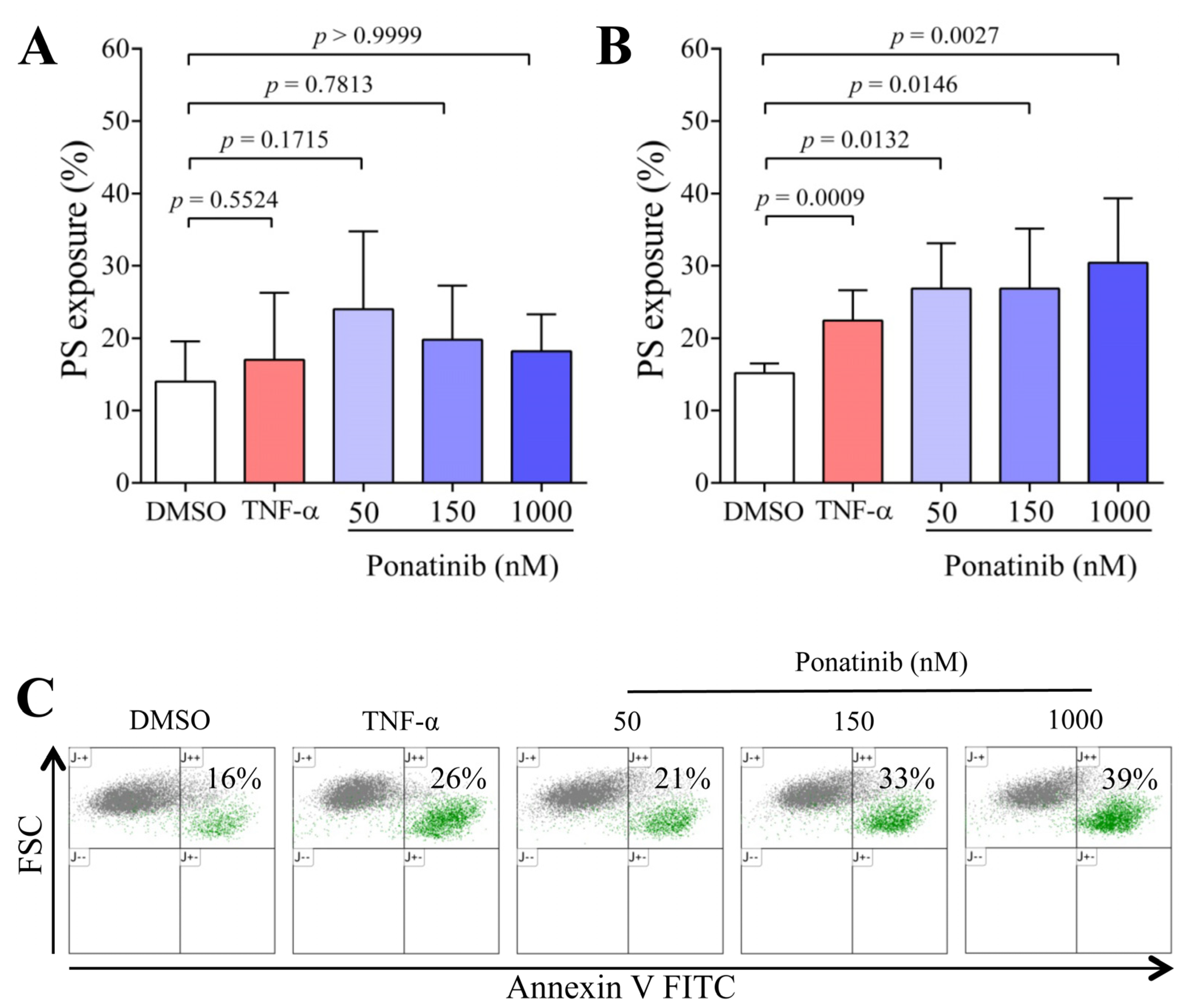
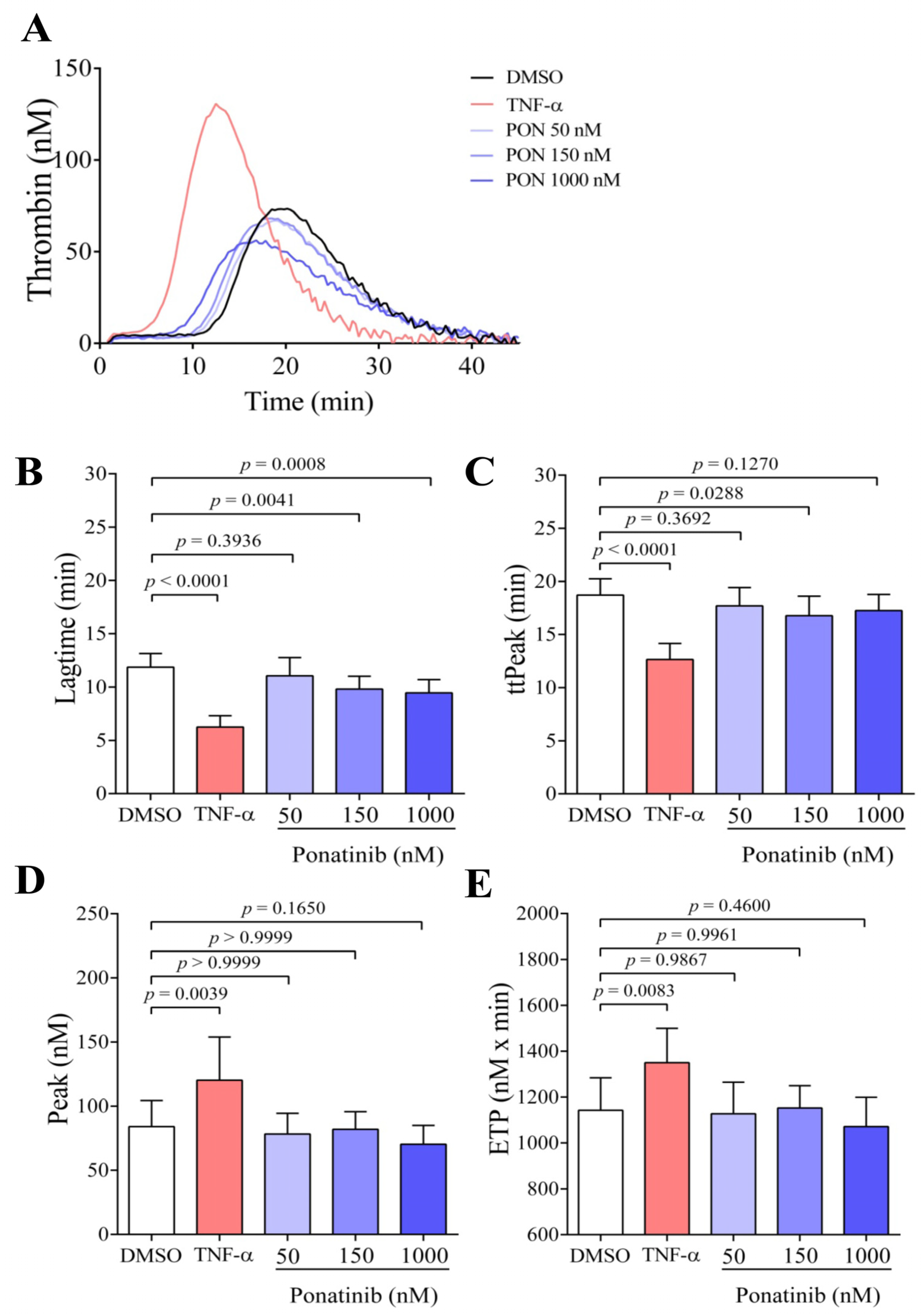

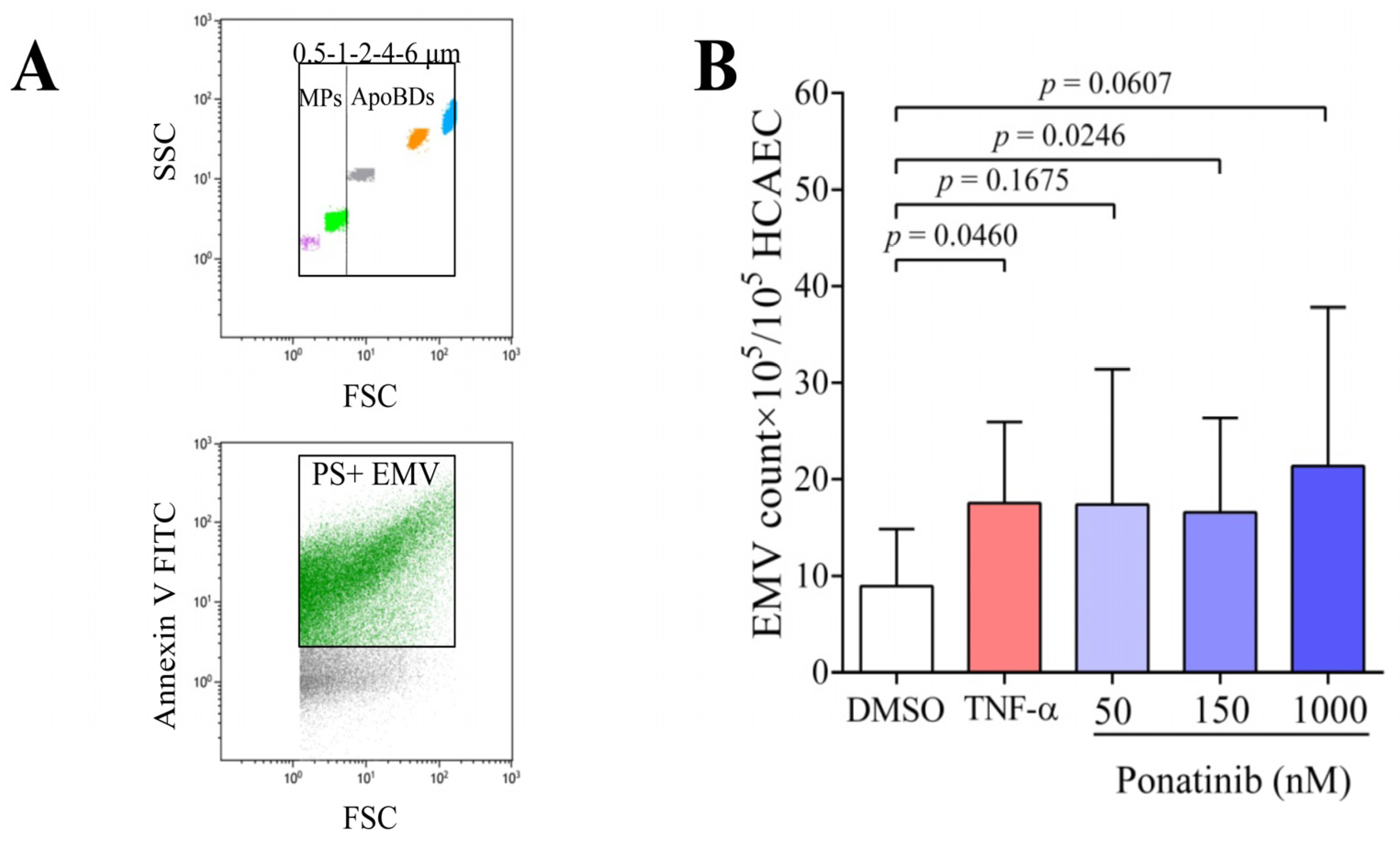
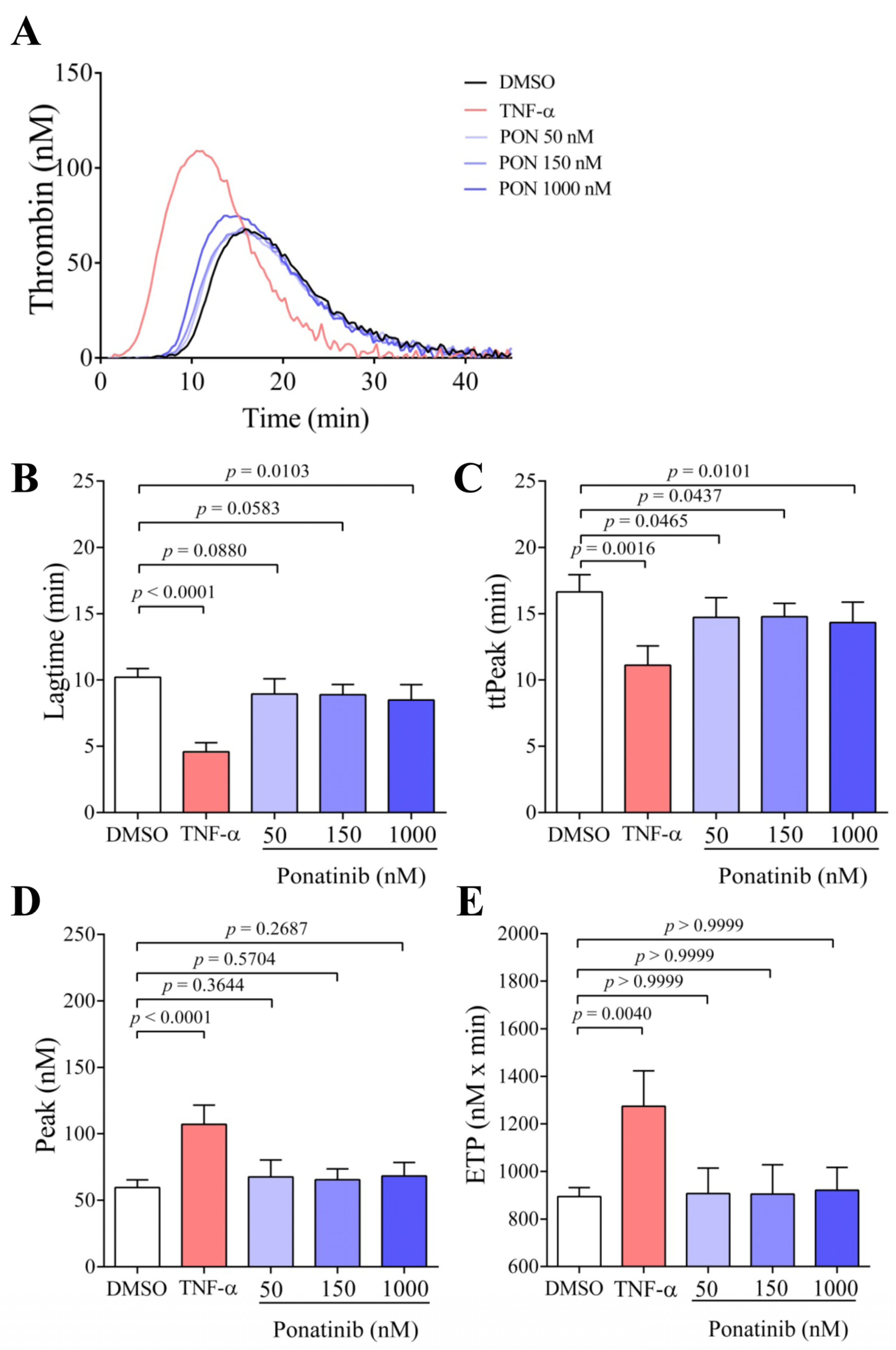
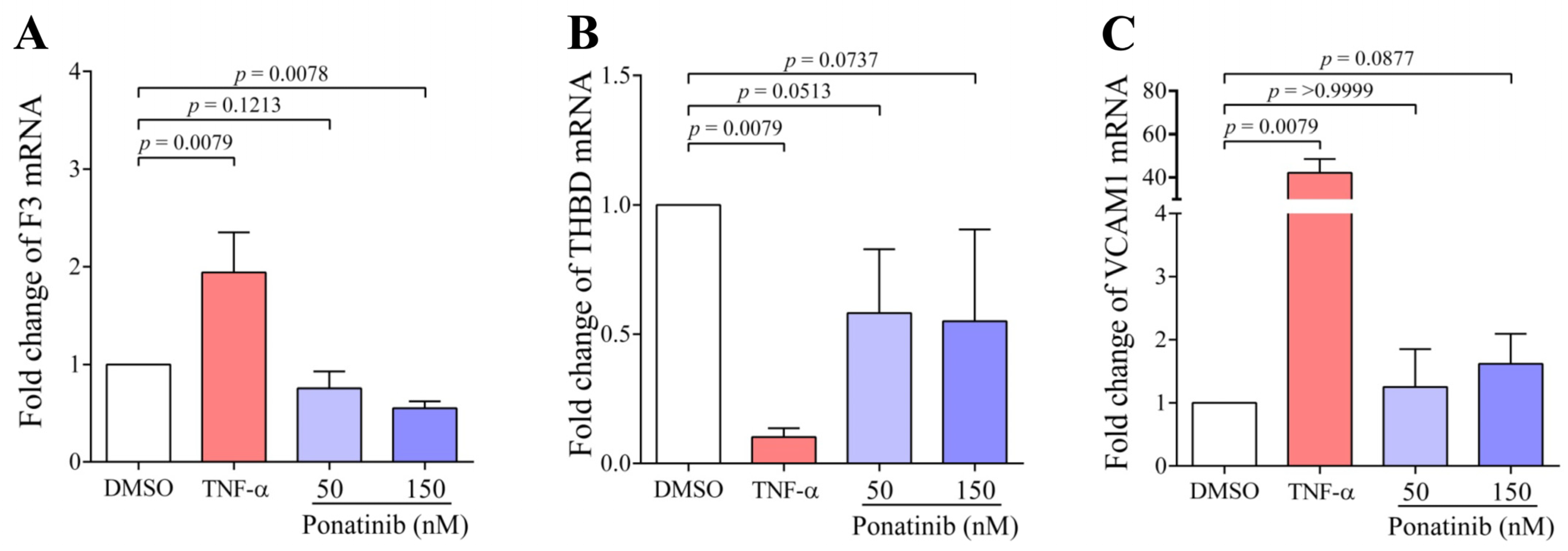
| Messenger RNAs | Forward Primers for RT-qPCR | Reverse Primers for RT-qPCR | Amplicon Length |
|---|---|---|---|
| F3 | 5′-CCCAGAGTTCACACCTTACCT-3′ | 5′-CGTTCATCTTCTACGGTCACA-3′ | 102 nt |
| THBD | 5′-GCTCCCCTCGGCTTACAG-3′ | 5′-GTTCTCCACGCTGCAGTC-3′ | 102 nt |
| VCAM1 | 5′-TGGACATAAGAAACTGGAAAAGG-3′ | 5′-GATTTCTGGATCTCTAGGGAATGA-3′ | 67 nt |
| RPLP0 (36B4) | 5′-ATGCAGCAGATCCGCATGT-3′ | 5′-TCATGGTGTTCTTGCCCATCA-3′ | 64 nt |
Disclaimer/Publisher’s Note: The statements, opinions and data contained in all publications are solely those of the individual author(s) and contributor(s) and not of MDPI and/or the editor(s). MDPI and/or the editor(s) disclaim responsibility for any injury to people or property resulting from any ideas, methods, instructions or products referred to in the content. |
© 2024 by the authors. Licensee MDPI, Basel, Switzerland. This article is an open access article distributed under the terms and conditions of the Creative Commons Attribution (CC BY) license (https://creativecommons.org/licenses/by/4.0/).
Share and Cite
Krajcsir, B.; Pócsi, M.; Fejes, Z.; Nagy, B., Jr.; Kappelmayer, J.; Beke Debreceni, I. Ponatinib Induces a Procoagulant Phenotype in Human Coronary Endothelial Cells via Inducing Apoptosis. Pharmaceutics 2024, 16, 559. https://doi.org/10.3390/pharmaceutics16040559
Krajcsir B, Pócsi M, Fejes Z, Nagy B Jr., Kappelmayer J, Beke Debreceni I. Ponatinib Induces a Procoagulant Phenotype in Human Coronary Endothelial Cells via Inducing Apoptosis. Pharmaceutics. 2024; 16(4):559. https://doi.org/10.3390/pharmaceutics16040559
Chicago/Turabian StyleKrajcsir, Bálint, Marianna Pócsi, Zsolt Fejes, Béla Nagy, Jr., János Kappelmayer, and Ildikó Beke Debreceni. 2024. "Ponatinib Induces a Procoagulant Phenotype in Human Coronary Endothelial Cells via Inducing Apoptosis" Pharmaceutics 16, no. 4: 559. https://doi.org/10.3390/pharmaceutics16040559
APA StyleKrajcsir, B., Pócsi, M., Fejes, Z., Nagy, B., Jr., Kappelmayer, J., & Beke Debreceni, I. (2024). Ponatinib Induces a Procoagulant Phenotype in Human Coronary Endothelial Cells via Inducing Apoptosis. Pharmaceutics, 16(4), 559. https://doi.org/10.3390/pharmaceutics16040559






